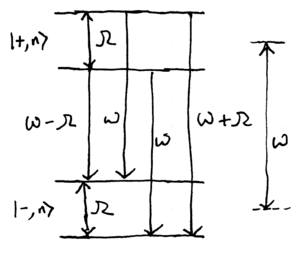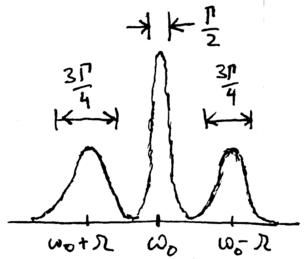Difference between revisions of "Solutions of the optical Bloch equations"
imported>Ichuang |
imported>Ichuang |
||
| Line 111: | Line 111: | ||
emission spectrum described by the coupled energy level diagram: | emission spectrum described by the coupled energy level diagram: | ||
::[[Image:Transient_and_steady_state_solutions_of_the_optical_Bloch_equations-obe-mollow-energy.png|thumb|306px|none|]] | ::[[Image:Transient_and_steady_state_solutions_of_the_optical_Bloch_equations-obe-mollow-energy.png|thumb|306px|none|]] | ||
| − | |||
where, to good approximation, the energy level differences are | where, to good approximation, the energy level differences are | ||
<math>\omega</math> and <math>\omega\pm\Omega</math>. These three lines which appear in the | <math>\omega</math> and <math>\omega\pm\Omega</math>. These three lines which appear in the | ||
spectrum are known as the Mollow triplet: | spectrum are known as the Mollow triplet: | ||
::[[Image:Transient_and_steady_state_solutions_of_the_optical_Bloch_equations-obe-mollow.png|thumb|306px|none|]] | ::[[Image:Transient_and_steady_state_solutions_of_the_optical_Bloch_equations-obe-mollow.png|thumb|306px|none|]] | ||
| + | |||
The Mollow triplet is experimentally observed in a wide variety of | The Mollow triplet is experimentally observed in a wide variety of | ||
systems. However, while our energy eigenstate analysis has predicted | systems. However, while our energy eigenstate analysis has predicted | ||
| Line 123: | Line 123: | ||
width of <math>3\Gamma/4</math>. To explain this, we need the optical Bloch | width of <math>3\Gamma/4</math>. To explain this, we need the optical Bloch | ||
equations. | equations. | ||
| + | |||
=== Rotating frame of reference for atom + field === | === Rotating frame of reference for atom + field === | ||
A simplification worth using in the study of the optical Bloch | A simplification worth using in the study of the optical Bloch | ||
Revision as of 00:27, 25 February 2009
The optical Bloch equations provide a time-dependent quantum description of a spontaneously emitting atom driven by a classical electromagnetic field. Considerable insight into the physical processes involved can be gained by studying these equations in the transient excitation limit, as well as the steady-state limit, as we see in this section. We begin by considering the coherent part of the evolution, then extend this to re-visit the Bloch sphere picture of the optical Bloch equations, which provides useful visualizations of transient responses and steady state solutions.
Contents
Eigenstates of the Jaynes-Cummings Hamiltonian
The optical Bloch equations are
where the Hamiltonian is
Useful limits to this equation of motion can be obtained, for example, by solving for in the steady state, when . Both the Hamiltonian part of this equation, and the damping part, are important to consider, and we begin here by reviewing the coherent evolution under . arises from the Jaynes-Cummings interaction we have previously considered in the context of cavity QED, describing a single two-level atom interacting with a single mode of the electromagnetic field:
The last term in this expression is , the dipole interaction between atom and field. By defining and , we may write this interaction as
In the frame of reference of the atom and field, recall that
When near resonance, , and because the and terms oscillate at nearly twice the frequency of , those terms can be dropped. Doing so is known as the rotating wave approximation, and it gives us a simplified interaaction Hamiltonian
Under this approximation, it is useful to note that this interaction merely exchanges one quantum of excitation from atom to field, and back, so that the total number of excitations is a constant of the motion. We may thus write the total Hamiltonian, in the rotating wave approximation, as
where we have defined , and . Below, we may use to simplify writing. What are the eigenstates of this Hamiltonian? It describes a two-level system coupled to a simple harmonic oscillator; when uncoupled, if , then the eigenstates are simply those of , and , as shown here:
\noindent When coupled, degenerate energy levels split, with harmonic oscillator levels and splitting into two energy levels separated by . Since the coupling only pairs levels separated by one quantum of excitation, it is straightforward to show that the eigenstates of the Jaynes-Cummings Hamiltonian fall into well defined pairs of states, which we may label as ; these are
and they have energies
When , similar physics result, but with slightly more complicated expressions describing the eigenstates, as we shall see when we later return to the "dressed states" picture.
Strongly driven atom: Mollow triplet
An atom strongly coupled to a single mode electromagnetic field, or an atom driven strongly by a single mode field, will thus have an emission spectrum described by the coupled energy level diagram:
where, to good approximation, the energy level differences are and . These three lines which appear in the spectrum are known as the Mollow triplet:
The Mollow triplet is experimentally observed in a wide variety of systems. However, while our energy eigenstate analysis has predicted the number and frequencies of the emission lines, it fails to explain a key characteristic: the widths are not the same. If the central peak at has width , the two sidebands each have a width of . To explain this, we need the optical Bloch equations.
Rotating frame of reference for atom + field
A simplification worth using in the study of the optical Bloch equations is a transformation into the rotating frame of the light field. The Hamiltonian for the atom + classical field may be written in general as
where parameterizes the strength field, is the atomic transition frequency, and are the Pauli matrices as usual. Define , such that the Schrödinger equation
can be re-expressed as
(4.1)
Since
Eq.(4.1) simplifies to become
where the terms on the right multiplying the state can be identified as the effective `rotating frame' Hamiltonian. The solution to this equation is
The concept of resonance arises from the behavior of this time evolution, which can be understood as being a single qubit rotation about the axis
by an angle
When is far from , the qubit is negligibly affected by the laser field; the axis of its rotation is nearly parallel with , and its time evolution is nearly exactly that of the free atom Hamiltonian. On the other hand, when , the free atom contribution becomes negligible, and a small laser field can cause large changes in the state, corresponding to rotations about the axis. The enormous effect a small field can have on the atom, when tuned to the appropriate frequency, is responsible for the concept of atomic `resonance,' as well as nuclear magnetic resonance.
Bloch vector evolution
We have previously seen that an arbitrary qubit state can be represented as being a point on a unit sphere, located at in polar coordinates. Similarly, a density matrix may be depicted as being a point inside or on the unit sphere, using
where is the Bloch vector representation of . Explicitly, if we let
then
Visulization of the evolution of a density matrix under the optical Bloch equations is thus helped by rewriting them in terms of a differential equation for . A convenient starting point for this is the optical Bloch equation
using the rotating frame Hamiltonian (suppressing )
This gives us the equations of motion
Note how these equations of motion provide a simple set of flows on the Bloch sphere: the terms correspond to a rotation in the plane, corresponds to a rotation in the plane, and drives a relaxation process which shrinks and components of the Bloch vector, while moving the component toward . Physically, what is the meaning of , , and ? is manifestly the population difference between the excited and ground states. The other two components may be interpreted by recognizing that the average dipole moment of the atom is
Thus, and correspond to the phase components of the atomic dipole moment which are in-phase and in quadrature with the incident electromagnetic field.
Transient repsonse of the optical Bloch equations
The optical Bloch equations allow us to study the internal state of the atom as it changes due to the external driving field, and due to spontaneous emission. Starting from the time-independent form of the equations,
we may note that when and at resonance, , the Bloch vector exhibits pure damping behavior, towards , and . When , Rabi oscillations occur, represnted by rapid rotations of the Bloch vector about . Since the relaxation along occurs at rate , and the relaxation about occurs at rate , we might expect that the average relaxation rate of the rotating components under such a strong driving field would be . The remaining component does not rotate, because it sits along , the axis of rotation. Thus, it relaxes with rate . Computation of the eigenvalues of the equations of motion verify this qualitative picture, and show that for , and , the eigenvalues of motion are and . These correspond to a main peak at with width , and two sidebands at , with widths , thus explaining the widths of the observed Mollow triplet lines.
Steady-state solution of the optical Bloch equations
The steady state solution of the optical Bloch equations are found by setting all the time derivatives to zero, giving a set of three simultaneous equations,
The solutions are (up to overall minus signs which can be absorbed into definitions):
Physically, these are Lorentzians; the solution (the component in quadrature with the dipole) corresponds to an absorption curve with half-width
and the solution (the component in-phase with the dipole) corresponds to a dispersion curve. And under a strong driving field, as , , indicating that the populations in the excited and ground states are equalizing. The steady-state population in the excited state is
an important result that will later be used in studying light forces. These solutions can be re-expressed in a simplified manner by defining the saturation parameter
in terms of which we find
As , the atomic transitions become {\em saturated}, and the linewidth of the transition broadens from its natural value , becoming on resonance, at .
![{\displaystyle {\dot {\rho }}=-{\frac {i}{\hbar }}[H,\rho ]-{\frac {\Gamma }{2}}\left[{\sigma _{+}\sigma _{-}\rho -2\sigma _{-}\rho \sigma _{+}+\rho \sigma _{+}\sigma _{-}}\right]\,,}](https://wikimedia.org/api/rest_v1/media/math/render/svg/604d2158dbbebf16674738f973827dbb18e3a819)




![{\displaystyle H_{JC}={\frac {\hbar \omega _{0}}{2}}\left[{|e\rangle \langle e|-|g\rangle \langle g|}\right]+\hbar \omega a^{\dagger }a+{\frac {\hbar \Omega }{2}}\left[{|g\rangle \langle e|+|e\rangle \langle g|}\right]\left[{a+a^{\dagger }}\right]\,.}](https://wikimedia.org/api/rest_v1/media/math/render/svg/630609e3aab033690555f530c6e4323ba84a5538)



![{\displaystyle H_{I}={\frac {\hbar \Omega }{2}}\left[{\sigma _{+}+\sigma _{-}}\right]\left[{a+a^{\dagger }}\right]\,.}](https://wikimedia.org/api/rest_v1/media/math/render/svg/3410ceeb8ffe707f367fc599209a8dad817b08df)





![{\displaystyle H_{I}={\frac {\hbar \Omega }{2}}\left[{a^{\dagger }\sigma _{+}+a\sigma _{-}}\right]\,.}](https://wikimedia.org/api/rest_v1/media/math/render/svg/508bc170a806987fec962bd6efde10f42f6acb93)













![{\displaystyle |\pm ,n\rangle ={\frac {1}{\sqrt {2}}}\left[{|e,n\rangle \pm |g,n+1\rangle }\right]\,,}](https://wikimedia.org/api/rest_v1/media/math/render/svg/55f08b48a6a98c378c7ba35aff03487dd1c3463e)













![{\displaystyle i\partial _{t}|\phi (t){\rangle }=\left[{e^{i\omega Zt/2}He^{-i\omega Zt/2}-{\frac {\omega }{2}}Z}\right]|\phi (t){\rangle }\,.}](https://wikimedia.org/api/rest_v1/media/math/render/svg/bd25a9fb634a32a02f90b6e2ac20fee9739e5132)

![{\displaystyle i\partial _{t}|\phi (t){\rangle }=\left[{{\frac {\omega _{0}-\omega }{2}}Z+gX}\right]|\phi (t){\rangle }\,,}](https://wikimedia.org/api/rest_v1/media/math/render/svg/d261013cb7bed576b4fc74be31542e84d10c527b)
![{\displaystyle |\phi (t)\rangle =e^{i\left[{{\frac {\omega _{0}-\omega }{2}}Z+gX}\right]t}|\phi (0){\rangle }\,.}](https://wikimedia.org/api/rest_v1/media/math/render/svg/98d107b245ae95facc20ec4573b03e27b7a613b5)









![{\displaystyle \rho =\left[{\begin{array}{cc}{\rho _{ee}}&{\rho _{eg}}\\{\rho _{ge}}&{\rho _{gg}}\end{array}}\right]\,,}](https://wikimedia.org/api/rest_v1/media/math/render/svg/614be7a08a95774b74f988c678248fd3055558a9)






























